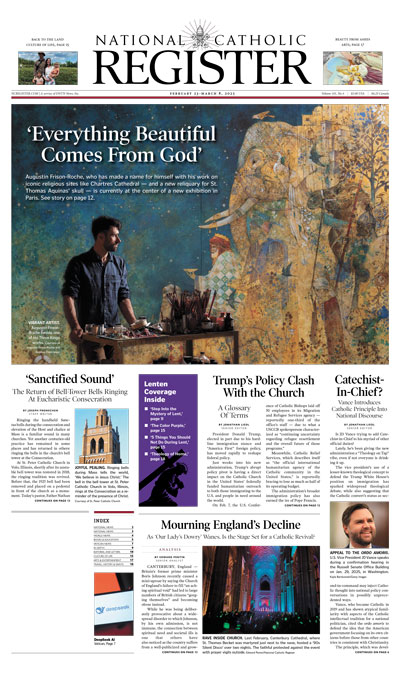Discovering Divine Mercy
A new pilgrim treks twice to The National Shrine of the Divine Mercy.

Kneeling before the Blessed Sacrament alone in an adoration chapel, I glanced over and was immediately captivated. Hanging there was a framed picture of the Risen Christ, white robe touching nail-scarred feet, red and white rays streaming from his heart. His eyes focused upon me with tremendous love.
Earlier that year, a friend had shown me this small sacred space known as a Divine Mercy Chapel, located behind a large Catholic church. We sat together in silence for a prayerful 15 minutes, practicing what I now call adoration.
Months later, on a bleak January afternoon, upon hearing some painful news, I rushed back to that same chapel. Running up the path from the parking lot, I opened the glass door and found the chapel empty — with Our Lord waiting. I fell to my knees before the Blessed Sacrament and poured out my heart to Jesus. It was my second time in adoration and my third month as a Catholic.
In time, my tears lessened, and it was then I saw the Divine Mercy image, written from a vision received by Polish nun St. Faustina Maria Kowalska in 1931.
What exactly is Divine Mercy? The word divine means “of God,” or “from God.” Mercy embodies “love’s response to suffering.” Put together, Divine Mercy equals God’s loving response to suffering — exactly what I saw in Jesus’ eyes that afternoon in the chapel.
Next came my online discovery of the National Shrine of the Divine Mercy in the Berkshire hills of western Massachusetts. It would make a convenient halfway stop on my annual trek to Maine in August. A special prayer service was being held on the evening I planned to arrive.
I drove the dark, wooded roads leading to the shrine’s entrance and parked along the driveway. Entering the shrine’s church, I found its pews nearly full, with penitents cued up along the side aisles awaiting the sacrament of reconciliation. I took my place in line.
A Marian Father heard my confession, and I felt compassion stream through the screen. The Divine Mercy was palpable.
I departed that night with a comforted heart and sore knees, having knelt at length on the hard marble floor before the altar.
My night’s lodging was the historic Red Lion Inn located in the heart of Stockbridge, a classic New England town. I planned to tour the shrine grounds briefly the next morning and leave in time to reach Maine before dark.
Morning dawned, following a deep, restful sleep.
My phone pinged, and I glanced down, pausing at the name — someone I rarely heard from and with whom I suffered a strained relationship. My jaw clenched. Would I be criticized? Blamed? Judged? Not wanting to taint this morning of pilgrimage, I decided to extend my day at the shrine until 3 p.m. — the hour of Divine Mercy — and wait until that moment to read the text.
A short, steep trek up from town, the national shrine sits atop Eden Hill, a sprawling 375 acres purchased by the Marian Fathers in 1943. I walked past quaint New England homes, enjoying the fresh beginnings of what promised to be a beautiful day.
Heading up the curved driveway, I followed the path between the Marian Fathers’ living quarters and the shrine offices to discover a vast outdoor amphitheater with wooden benches extending in both directions. The space, known as The Mother of Mercy Outdoor Shrine, was built in 2007 to accommodate massive crowds, but on this Thursday morning, I was the lone pilgrim. To the left on a small platform stood a statue of Christ beckoning out over the valley and rolling hills beyond. I lifted my eyes to the hills, reminding myself that, like the Psalmist, my help comes from the Lord who created heaven and earth.
Next, I came upon the outdoor Holy Family Shrine, featuring an arbor and reflection pool, with a portico sheltering a statue of the Holy Family. The colonnades were lined with candles, drawing pilgrims to offer pointed prayers.
I then headed to the shrine church, now empty and open for prayerful reflection and contemplation of the extensive artwork and numerous relics. The Divine Mercy Image hung over the high altar, surrounded by golden rays. Also above the high altar, wooden carvings of the Twelve Apostles stood shoulder to shoulder. I contemplated these, identifying each one by name.
Turning to the right, I entered a side chapel featuring first-class relics both of St. Faustina and her spiritual director, Blessed Michael Sopoćko, along with a relic of St. Margaret Mary Alacoque. A glass case held the zucchetto cap of Pope St. John Paul II given to the national shrine in 2000, shortly after St. Faustina was canonized.
The morning flew by, and I found myself sitting in a pew gazing upon the intricate beauty of the chapel while awaiting the Divine Mercy Chaplet at 3 p.m. Then, I would read the text.
At 2:59, I pulled out my phone, hands shaky. And what I found written there was an apology of sorts. A few lines mentioned ways in which the writer had been less than kind and concluded that I might understandably be angry. The chaplet began and I joined in, repeating aloud all 50 times, “For the sake of his sorrowful passion, have mercy on us and on the whole world.” I then texted a response and pray my words displayed Divine Mercy to the recipient.
My second visit to the National Shrine of the Divine Mercy was five years later, again en route to Maine — this time with my 16-year-old son Trevor. I insisted we make a shrine visit on our way north, but Trevor was unhappy at the thought of delaying his vacation. I promised we’d stay just one hour.
We parked that morning along the shrine road in front of the Marian Fathers’ living quarters and headed back to the sprawling Mother of Mercy Outdoor Shrine, then over to the statue of Christ. From there, we stopped along the walkway to study the bronze statue of Pope St. John Paul II, patron of the Marian Fathers, and then stepped into the carved haven that was the shrine church. We were the only pilgrims at this early hour.
Trevor was immediately taken with the intricate woodwork, the apostles’ carvings above the altar, and the relics and sculptures of the side chapels. I lingered among the pews, gazing upon the 36 stained-glass windows and two mosaics. Glancing back towards the upper loft, I noticed an organ. Trevor was a budding organist and loved exploring any organ he encountered.
The hum of a vacuum sounded through the chapel doors, where a man was cleaning the narthex rug. I pushed open the doors.
“My son plays the organ,” I half shouted above the vacuum noise. “Would it be possible to go up to the loft to see the organ?”
He turned off the switch and I repeated myself, to which he replied that the loft is kept locked and isn’t open to visitors. Curious about the person standing before me, I asked how he came to work at the shrine. He hesitated, “You don’t really want to hear my story.” But I did, and Trevor joined me as Joe, an employee who maintains the shrine’s buildings and grounds, shared how he had worked in commercial real estate, managing apartment buildings.
“But I sometimes would have to evict single mothers who couldn’t pay their rent and it just didn’t feel right.” Disillusioned with years of secular work, Joe left it all to work at the shrine. His story touched my heart.

With the day now half over, we bade farewell to Joe, but not before he urged us to walk down to the area below the extensive Mother of Mercy Outdoor Shrine to the Grotto and Shrine of the Holy Innocents. Trevor was willing, and we took the secluded path down through the woods, curving around to a patio area underneath the stage.
A striking replica of the Grotto at Lourdes offered pilgrims opportunity for prayers and candle lighting. To the left, a short path showed a child’s footprints cast in cement, leading the way to the Shrine of the Holy Innocents. We were unprepared for the emotions that hit as we entered. Several other pilgrims knelt, quietly grieving. Colorful glass tiles lined the walls, memorializing specific innocents by name. One especially poignant tile read, “2 unborn babies 1983 May you & God forgive me & fathers like me.” My own tears joined the ocean of sorrow and regret that flowed in this underground space where little lives were never forgotten.
Somberly, we departed and headed up toward the car, but not before Trevor noticed the life-size Stations of the Cross across the way.

We searched up Mother Angelica’s Stations of the Cross readings via EWTN on Trevor’s phone, and he read them aloud as I responded. Together we walked the 14 stations, experiencing the Lord’s passion as depicted by more than 50 bronze sculptures.
After perusing the gift shop, where Trevor was drawn to a framed canvas of the Divine Mercy image with gold stars in the background, we capped off the day with Mass, followed by the Divine Mercy Chaplet. Our one hour had turned into five. Spiritually satiated, we strolled down the road towards our car. Glancing over my shoulder, I recognized from a distance Marian Father Chris Alar, having seen him host the Living Divine Mercy show on EWTN. It seemed the suitable completion of a significant day.

Yet, as we headed off to Maine, my thoughts returned to shrine worker Joe, a contented “doorkeeper” serving in the house of God. His reasons for working at the shrine were an act of Divine Mercy all their own.
Lisa Livezey writes from Pennsylvania where she found her way to Rome via the Anglican Ordinariate. She is the author of Minding Mom: A Caregiver’s Devotional Story (En Route Publishing) and posts weekly photo devotions at lisalivezey.com/olivetree.















